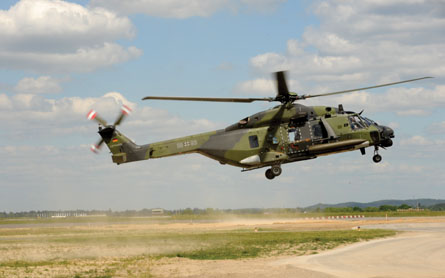The German Army is showing off its newest operational helicopter at ILA. The Heer was the first customer to take delivery of the NH90, and is the largest customer for the type so far, with 80 firm orders and 54 options. The German air force has ordered 42 more.
Demand for the aircraft is strong, but the programme has run behind schedule, largely as a result of minor software problems. As a result, deliveries to some customers have suffered high-profile delays, and the biggest problem facing the NHI consortium is keeping pace with customer expectations. Despite this, NHI is eager to receive further orders at ILA.
The NH90 is being produced by the NHI consortium, a joint venture between Europe’s major helicopter companies (62.5% EADS Eurocopter, 32.5% AugustaWestland, and 5% Stork Fokker). The company already has an order book for more than 500 helicopters, for 18 customers in 14 countries, and the type is now entering service in growing numbers.

The first three NH90 Tactical Transport Helicopters (TTH) for the German Army Aviation (Heeresfliegertruppe) were handed over at Eurocopter’s Donauwörth facility on December 13, 2006, following the issue of German type certification on December 1. The first operational unit is Transport Helicopter Regiment 10, based at Fassberg.
Originally designed as a shipborne naval helicopter (and known as the NFH or NATO Frigate Helicopter) the NH90 was sized to fit between smaller naval helicopters like the Lynx, and larger Sea King/Merlin sized aircraft, and was optimized for autonomous ASW and ASuW missions, with vertical replenishment; SAR; transport; and minelaying as secondary roles.
The NFH is usually operated by a crew of three, with a pilot ‘up front’ and a tactical co-ordinator and a sensor systems operator in the cabin, which also accommodates the dipping sonar and sonobuoy launcher. The aircraft’s sensors include a Thales European Navy Radar (ENR) 360 degree surveillance radar mounted under the nose. Swedish aircraft will use the Telephonics AN/APS-143(V)3 Ocean Eye radar. NFH also has an under-nose FLIR, a Magnetic Anomaly Detector (MAD) and a sonar system.
French NFH aircraft use the Thales Underwater Systems Flash Sonics sonar system, while Norwegian and Swedish Navy NFH will use the Flash-S version of the system, optimised for conditions in the Baltic Sea. German, Italian and Dutch NFHs will use the L-3 HELRAS dipping sonar.
It soon became clear that the basic NH90 design would form an excellent basis for a tactical transport helicopter in the same broad class as the Sikorsky Blackhawk, but offering all of the advantages of the latest technology and materials. The twin-engined NH90 can carry up to 20 troops, a light patrol vehicle or 12 stretchers. In June 2007, Sweden became the launch customer for a High Cabin Version (HCV) of the TTH, with a taller 1.82m cabin instead of the standard cabin height of 1.58m. The Luftwaffe has ordered a dedicated Combat Search and Rescue (CSAR) version.
The aircraft is equipped with an advanced all-electric, full-authority quadruplex fly-by-wire (FBW) flight control system, and was the first medium-sized transport helicopter to fly with full FBW controls, with no mechanical back-up. The aircraft is fitted with a full glass cockpit incorporating five 8in by 8in colour multifunction liquid crystal displays, and state-of-the-art communication, navigation and mission equipment.
The helicopter uses the same Thales Topowl helmet-mounted sight as the Tiger attack helicopter. The full composite fuselage and crash-resistant, self-sealing cells set new standards of crashworthiness and the helicopter is fitted with large sliding doors and a rear ramp for maximum flexibility.
Like the three-engined AW101, the twin-engined NH90 is offered with Rolls Royce/Turbomeca RTM 322 or GE T700/T6E1 engines, the latter having been selected by Italy and Spain.
The NH90 was well-sized to meet emerging new tactical helicopter requirements, and to meet a growing demand for replacements for older Pumas, UH-1 Hueys, and aircraft like the Mi-8, and its success was rapid. Today, significantly more TTH tactical transport versions have been sold than naval NFH versions.
The NH90 programme began on September 1, 1992, when the new NATO Helicopter Management Agency (NAHEMA), comprising Germany, Italy, France and the Netherlands, signed an NH90 design-and-development contract with NH Industries. Design work started in 1993, and the first NH90 prototype flew in December 1995.
The NH90 production programme was launched in June 2000, with orders for 243 aircraft from Germany (80 TTH), Italy (70 TTH and 46 NFH), France (27 NFH) and the Netherlands (20 NFH). Germany subsequently increased its commitment to 122 TTHs and has a requirement for 38 NFH helicopters, while France has added 12 TTH helicopters to its NFH order, with 56 options. Portugal joined NAHEMA in June 2001, with OGMA joining the industrial partnership. Portugal’s requirement was for 10 NH90 TTH helicopters.
The NH90 received a major boost in 2001 when it was selected to meet the Nordic Standard Helicopter Programme (NSHP) requirement. Sweden has ordered 18 (13 TTT, five NFH), Finland 20 TTH and Norway 14 NFH (six for ASW and six for the coastguard). Spain ordered 45 TTHs in 2006, and Belgium ordered four NFH and four TTH last year.
Greece ordered 20 TTH (four for special operations) in 2003 and the Royal Air Force of Oman ordered 20 more in July 2004. Australia selected what it called the MRH-90 to meet its Air 9000 requirement in August 2004, ordering 12 TTH equivalents for the Army in June 2005. 34 more were ordered for the Royal Australian Navy in June 2006. Neighbouring New Zealand selected the NH90 was to replace the RNZAF’s ageing UH-1H helicopters in April 2005, and signed a contract for nine TTH in July 2006.
Visit the official Berlin Air Show site
Flight's ACAS Business Aviation
Flight's products including the Business Aircraft Pocket Guide
All the show news, pictures, blogs, and video.
All the news from ILA 2008
Source: Flight Daily News























